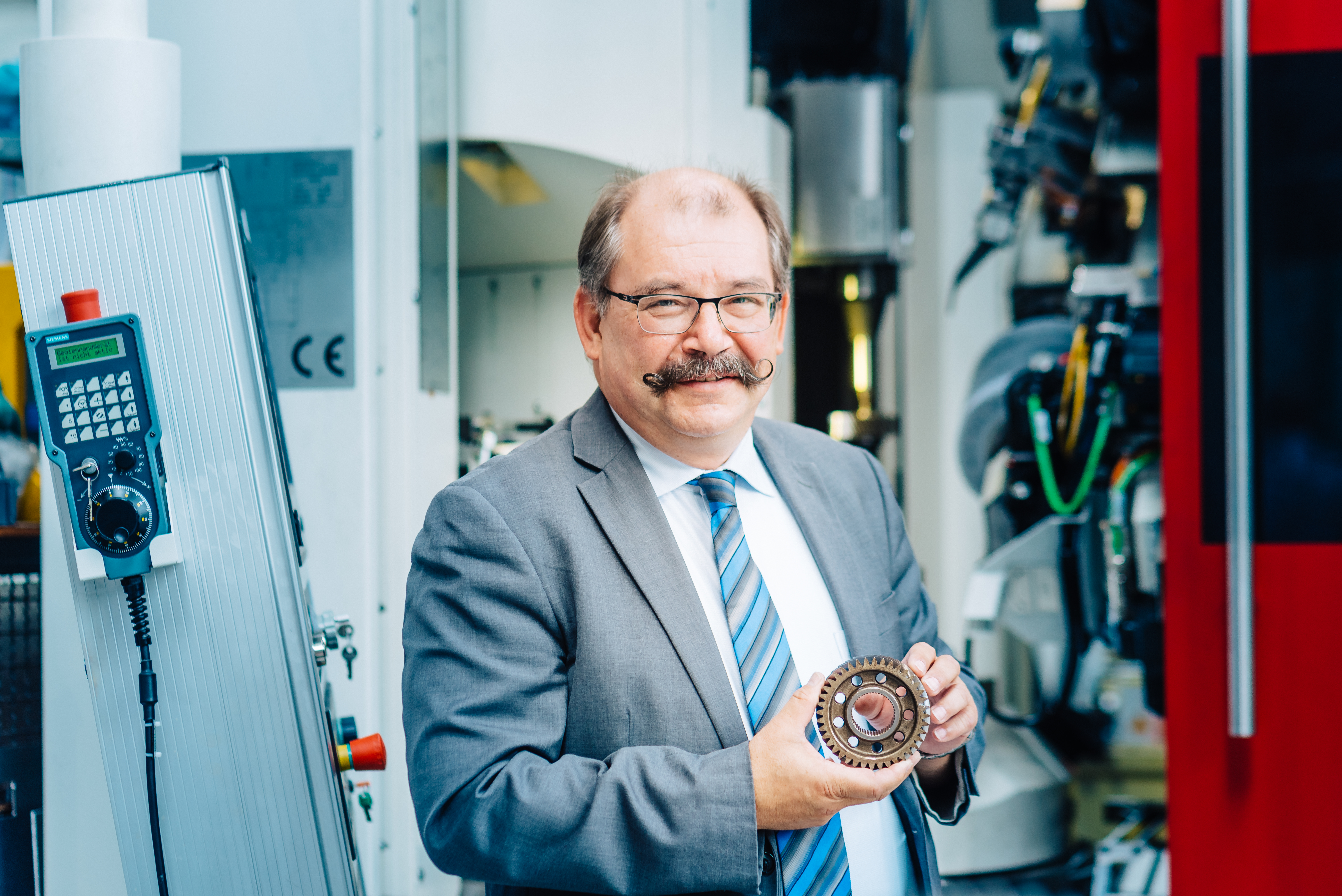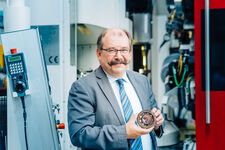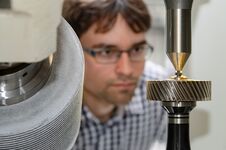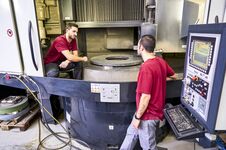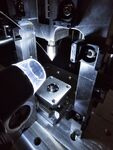Pressure for change reaches the grinding technology industry
Manufacturers of abrasives and grinding and dressing tools are therefore being affected by development trends. Since these manufacturers are increasingly faced with ever more new materials and material compounds, they are coming under more pressure to innovate and reduce their costs. It is necessary to exploit optimization potential along the process chain and therefore also profit, if possible, from new processes and findings from scientific research.
Since extensive grinding technology applications are decreasing in the powertrain of internal combustion engines, there is an urgent need to find alternative markets according to Prof. Bernhard Karpuschewski, Director of Production Engineering at the Leibniz Institute for Material-Oriented Future Technologies (IWT) in Bremen. The scientist, who is also a member of the German Academic Association for Production Technology (WGP), a group of leading professors for production sciences, sees a number of highly promising developments.
Good prospects for additive manufacturing
"Precision machining of composite materials is certainly one of the expanding new application areas," said Karpuschewski. The Bremen-based scientist also regards post-processing of additively manufactured components as a rapidly growing area, especially since no ready-to-install functional surfaces could be even printed in the foreseeable future. Karpuschewski: "An increasingly important role is also being played here by the development of additively manufactured grinding wheelbase bodies in which complex inner cooling channels, for example, can be integrated. This also applies to the additive application of a grinding layer which can be attained, for example, by means of blasting processes." In general, Prof. Karpuschewski sees growing demand for surfaces with the highest possible surface qualities, for example polish grinding of gears, for which adapted grinding discs in an elastic bond and adapted dressing technologies are required.
GrindingHub, a trend trade fair
The changes in the industry and the associated impacts on production and production technologies will also probably shape the discussions at GrindingHub, which will be held in Stuttgart from 14 to 17 May 2024. This grinding technology trade fair, which is being staged by the German Machine Tool Builders' Association (VDW), will provide an overview of innovations and current trends.
The exhibitors at GrindingHub include Diamant-Gesellschaft Tesch GmbH from Ludwigsburg. The company's product portfolio comprises grinding tools in different bond systems as well as dressing tools. Tesch specializes in super hard materials. Managing Director Dr. Georg Gerlitzky is convinced: "Due to the use of new materials, utilization of highly hard cutting materials such as cBN and diamond during grinding and dressing will become even more important."
According to Gerlitzky, the industry is being affected by both the increasing technological demands and the deteriorating general conditions. "Although the grinding market has an advantage in that it offers numerous niches in which specialized medium-sized companies can work successfully, the pressure for change calls for continuous re-evaluation: How is the market changing? How do I react as a company?" Tesch therefore focused on automation and documentation of empirical knowledge at an early stage in order to prevent a shortage of skilled workers. In the case of supply chains it was necessary to counteract the dependence on China. A strategic decision was therefore taken in Ludwigsburg to purchase 20 per cent of super hard materials from regions other than China despite much higher costs. Tesch has a high production depth and produces solely in Germany. Raw materials have to be imported.
New materials as innovation drivers
According to the Managing Director, the biggest technological challenges primarily involve the handling of new materials for which grinding solutions have to be found at ever shorter time intervals: "At times, we have to deal with a very large number of material compounds," he said. This development is also a topic for Prof. Karpuschewski at the IWT in Bremen. "Processing of new materials and material compounds has long been known to us from geometrically defined cutting and precision machining of optical materials," he stated. "From a scientific viewpoint, we are actively addressing these questions and working on a large number of technological solutions. The key factor is the evaluation of process influences on component quality in different materials for which extensive physical analysis is carried out in Bremen.
More time and effort for imparting process know-how
An interdisciplinary research team is working on tool development at Tesch. Tools often have to be adapted individually to customers' requirements. The process support costs are also increasing. "There is an ever increasing need to impart know-how to users in order to ensure high-quality and reproducible grinding processes," emphasized Georg Gerlitzky. This always depends on highly qualified personnel with many years of experience.
Cooperation with scientific institutes has a long tradition at Tesch. By its own account, the company collaborates with different institutes, is active in various working parties and values exchanges. This also includes participation in research projects. The company is currently working with Berlin Technical University on a project involving the production of metallic grinding tools with the aid of additive manufacturing.
Know-how transfer through research projects
The grinding experts in the Institute of Machining Technology (ISF) at Dortmund Technical University are also convinced about the positive prospects for additive manufacturing. Dr. Monika Kipp, Head of the Grinding Technology Department, stated in this respect that additive manufacturing is now being used in the grinding technology industry and is opening up new prospects.
A number of research projects involving new production processes and alternative tool concepts are currently being conducted at the ISF. According to Dr. Kipp, the highlights include basic studies on the use of diamond-coated foam materials for precision surface treatment which enable purposeful processing of filigree structures. Two other projects confirm the growing importance of diamond and cBN. For example, one group is involved in the identification of microscopic wearing mechanisms of diamond and cBN in precision grinding of hardened steel. In another project studies are being carried out on cold gas spraying for the manufacture of cBN metal composite layers and their qualification for use as a grinding tool. This also comes within the context of additive manufacturing.
Monika Kipp sees a great opportunity in the close cooperation between science and industry. She said that, thanks to the constant exchanges, both science and companies obtain suggestions for new topics and research projects. On the other hand, the institutes could provide support through basic research or generate substantial value-added through references to related research results. The ISF has cooperation partnerships with both larger enterprises and smaller companies.
Exploit potential in the area of sustainability
Just like other areas of industrial production, the topic of sustainability is also affecting grinding technology. Karpuschewski primarily sees two starting points for the grinding process: "In Bremen we have been preoccupied for many years with need-based use of cooling lubricants during grinding since this still harbors enormous saving potential. Thanks to adapted feed and a nozzle design, energy consumption can be drastically reduced while still maintaining the same component quality. This has a direct effect on the sustainability of the process. In the light of rapidly increasing energy costs, new promising approaches could also open up when recycling grinding waste.
According to Managing Director Gerlitzky, Diamant-Gesellschaft Tesch has long been committed to energy-saving and resource-conserving production although tool manufacturers are rather limited in the ways they can influence its use at their customers. At Tesch, for example, the primary energy source - electricity - has been changed completely to green electricity from hydroelectric power plants. This was made possible through cooperation with a local partner. "The topic of sustainability should be part of the DNA of every medium-sized company," emphasized Gerlitzky. "We must position our company here in a progressive way as only then can we secure advantages in the long term."
(9,315 characters incl. spaces)
Author: Cornelia Gewiehs, freelance journalist, Rotenburg (Wümme)
Our press release is also available for download: Download press release (PDF, 221 KB)
zurück zur Übersicht